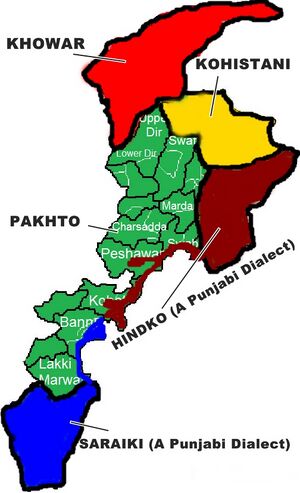Mardan

Mardan is a City and district in the Khyber Pakhtunkhwa province of Pakistan.
Location
The district lies from 34° 05' to 34° 32' north latitudes and 71" 48' to 72° 25' east longitudes. It is bounded on the north by Buner district and Malakand protected area, on the east by Swabi and Buner districts, on the south by Nowshera district and on the west by Charsadda district and Malakand protected area.
Origin of name
The name means the land of brave men.
Tahsils
The district of Mardan is administratively subdivided into three tehsils, these are:
History
Mardan District is a part of the Peshawar valley the whole area was once part of the ancient kingdom of Gandhara, the remains of which are scattered throughout the district.
The armies of Alexander the Great reached the Indus Valley by two separate routes, one through the Khyber Pass and the other led by Alexander himself through Kunar, Bajaur, Swat, and Buner in 326 BCE.
After Alexander's death, the valley came under the rule of Chandragupta, who ruled the valley from 297 to 321 BCE. During the reign of the Buddhist emperor Ashoka (the grandson of Chandragupta) Buddhism became the religion of the Peshawar Valley.
The valley saw the revival of Brahmanism after the Greeks took over in the time of King Mehanda.
The Scythians and Indians followed and retained control of the valley till the 7th century CE.
By the 8th century, the Afghans had appeared in the valley. At that time the Peshawar valley was under control of the rulers at Lahore. The Afghans joined the Gakkhars who held the country between the Indus and the Jhelum rivers and compelled the Lahore rulers to cede to them the hill country west of the Indus and south of the Kabul River.
n the 10th century the area came under the control of Sultan Sabuktigin who defeated Raja Jaipal, the Hindu ruler of Lahore. Sabuktgin's son Sultan Mahmud of Ghazni made this area the rallying point for his numerous raids into the interior of India.
In the 12th century the Pashtun of Ghor overthrew the Ghaznavis and the era of Ghaznavis came to an end.
In 1505 the Mughal emperor Babur invaded the area through Khyber Pass. The most prominent rathan of emperor Akbar - Beerbal was killed in the Katlang Area during a battle with the Yousafzai tribe. Baber was defeated in Swat three times. The People of swat in those days were of mix origins. On one side of the river lived Pashtun along with Gujars, syriake people of whom many were Sikhs and Hindus and Muslims. They all together march against Baber and defeated him three times. Baber then married some young lady of a Pashtun ruler from Bunair and made a peace treaty but had no control of the area except by word. During his Aurangzeb regime the Pashtun tribes revolted and Aurangzeb himself led his army to re-establish his authority but after a hard struggle which lasted for two years (1673–75) he was compelled to agree to the terms which left the Pashtuns practically independent.
In 1738 came the surrender of Peshawar to Nadir Shah by which all the territory west of the Indus, which included present Mardan district was ceded by the Mughals to Nadir Shah.
Ranjit Singh conquered Attock 1814 and Peshawar city in 1822. He left Hari Singh Nalwa in command and withdrew himself to Lahore. Peshawar city, Nowshera and Hazara were under Sikh rule for a while. Hazara was set free by tanooli clane from Sikhs but fell to Britain in 1838. Peshawar city also fell to Pashtuns in 1834. Hari Singh Nalwadied in the Battle of Jamrud] but soon the British took it in 1837. The British then went after the Sikhs and the Sikh were defeated by the British in the Second Sikh War. Major Lawrence was appointed first Deputy Commissioner of Peshawar. From that time Peshawar city and Attock regions only (This does not include most of what is Khyber-Pakhtunkhwa today) became an administrative district under the Punjab Government.
In 1909 Khyber-Pakhtunkhwa (then NWFP) was constituted and in 1937, Peshawar district was bifurcated into Peshawar and Mardan districts. Britain tried its best to include FATA, DIR, Swat and other region into Khyber-Pakhtunkhwa but they suffered heavy setback and finally came to an agreement in 1920s that Britain will no longer bother the tribes and swat region.
Places of Historical Importance
The district also contains the famous archaeological site of Takht Bhai, Jamal Ghari and Sawal Dher.
Rivers and streams
Generally stream flows from north to the south. Most of the streams drain into Kabul river. Kalpani, an important stream of the district rises in the Baizai and flowing southwards join Kabul river. Other important streams which join Kalpani are Baghiari Khawar on the west and Muqam Khawar, coming from Sudham valley and Naranji Khawar from the Narangi hills on the left.
Notable persons
External Links
References
Back to Jat Places in Pakistan

